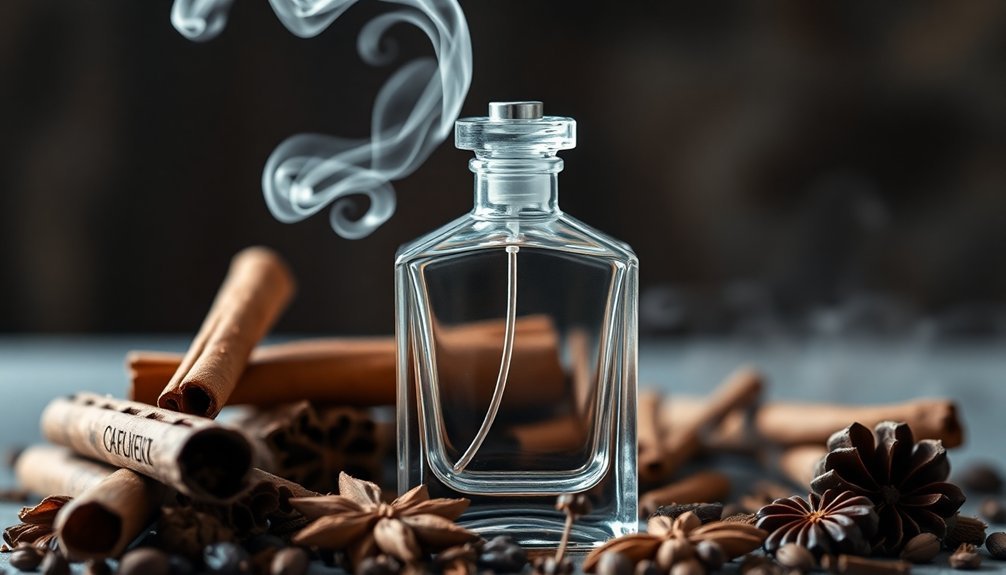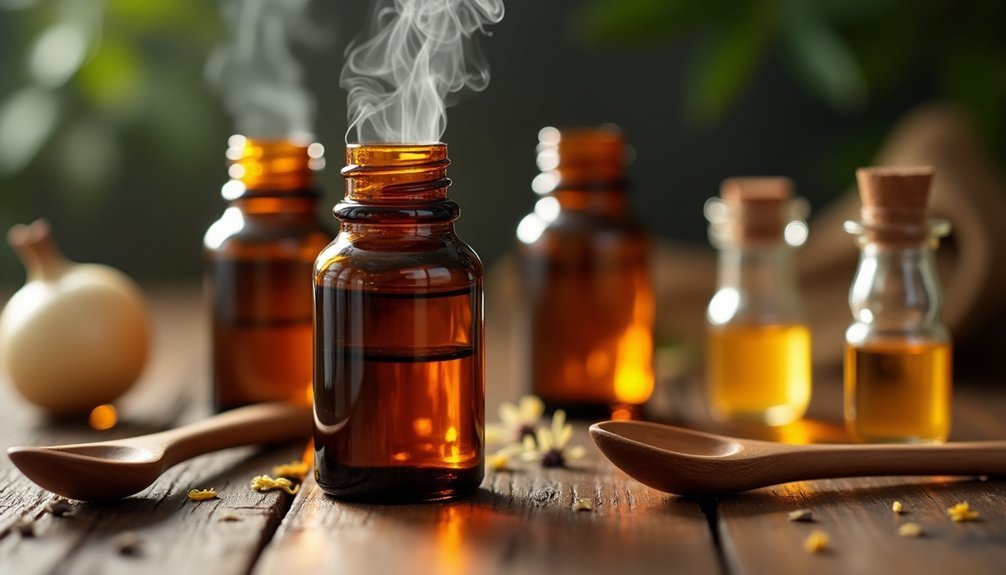When mixing base notes, start with a balanced 20% ratio in your blend and follow three key tricks: First, pair woody bases with floral middle notes for natural harmony. Second, apply directly to pulse points and test small batches on your skin to reveal true compatibility. Third, allow your blend to rest 3-5 days before making drop-by-drop adjustments. These foundational techniques will unveil the artistry of creating sophisticated, long-lasting fragrances.
Understanding Base Note Intensity and Compatibility

When crafting your own fragrance, understanding base note intensity and compatibility is crucial for achieving a well-balanced blend.
You'll need to contemplate how different base notes interact, as some are more potent than others. For example, while myrrh delivers a strong presence, vetiver offers a lighter touch to your overall composition.
Pay attention to compatibility when combining base notes with other elements. Woody base notes work particularly well with floral middle notes, creating a harmonious blend that adds depth to your fragrance.
Remember to maintain the recommended blending ratio of 20% for base notes to guarantee they support rather than overpower your creation.
Don't forget to test your mixture on your skin, as personal body chemistry can greatly influence how these base notes develop and interact.
Layering Techniques for Long-Lasting Harmony
To achieve a lasting and harmonious fragrance, mastering the art of layering base notes requires strategic application techniques. When practicing fragrance layering, you'll want to start by applying your base notes directly to your skin, followed by complementary scents that enhance your unique scent profile.
For maximum longevity, apply your fragrances to pulse points where body heat naturally helps diffuse the scent throughout the day. You can mix and match by applying different scents to separate areas, allowing them to blend naturally without overwhelming each other.
Consider incorporating scented lotions that complement your base notes to intensify the overall fragrance. Remember to start with lighter applications and gradually build intensity – this gives you better control over your layering techniques and guarantees a well-balanced, harmonious result.
Testing and Adjusting Your Base Note Blend

Once you've mastered the basics of layering, the next step involves testing and fine-tuning your base note combinations. Start with a small batch using standard proportions, then let your fragrance combination rest for several days to develop its true aroma. As you experiment, test the blend on your skin to understand how your body chemistry affects the scent.
| Testing Phase | Adjustment Method |
|---|---|
| Initial Mix | 30/50/20 ratio |
| Rest Period | 3-5 days aging |
| Skin Test | Apply to pulse points |
| Fine-tuning | Drop-by-drop method |
| Final Blend | Document proportions |
When adjusting your base notes, add one drop at a time while documenting changes. Don't be afraid to explore different combinations – this exploration adds depth to your creation and helps you understand how various notes interact.
Frequently Asked Questions
What Is the 30/50/20 Rule for Essential Oils?
You'll want to blend your essential oils using 30% top notes for initial scent, 50% middle notes for body, and 20% base notes for depth, creating a balanced fragrance composition.
What Fragrance Notes Go Well Together?
You'll find vanilla pairs beautifully with sandalwood, while rose complements patchouli. Try combining amber with cedarwood, or mix lavender with bergamot. Citrus notes blend well with most florals and woods.
How to Blend Top, Middle, and Base Notes?
Start with your base note, then layer middle notes at 50% concentration. Add top notes last at 30%. Let the blend mature for several days, allowing the fragrances to meld together harmoniously.
How to Mix Fragrance Notes?
Start with your base note, then add middle and top notes using a 20:50:30 ratio. You'll want to document each drop, let the blend mature for days, and test it with your body chemistry.
In Summary
Now you're equipped to create stunning base note combinations that'll transform your fragrance game. Remember to evaluate note intensities, layer strategically, and test your blends before finalizing. Don't be afraid to adjust proportions until you achieve the perfect harmony. With these three techniques in your arsenal, you'll master the art of mixing base notes and create signature scents that truly stand out.





Leave a Reply